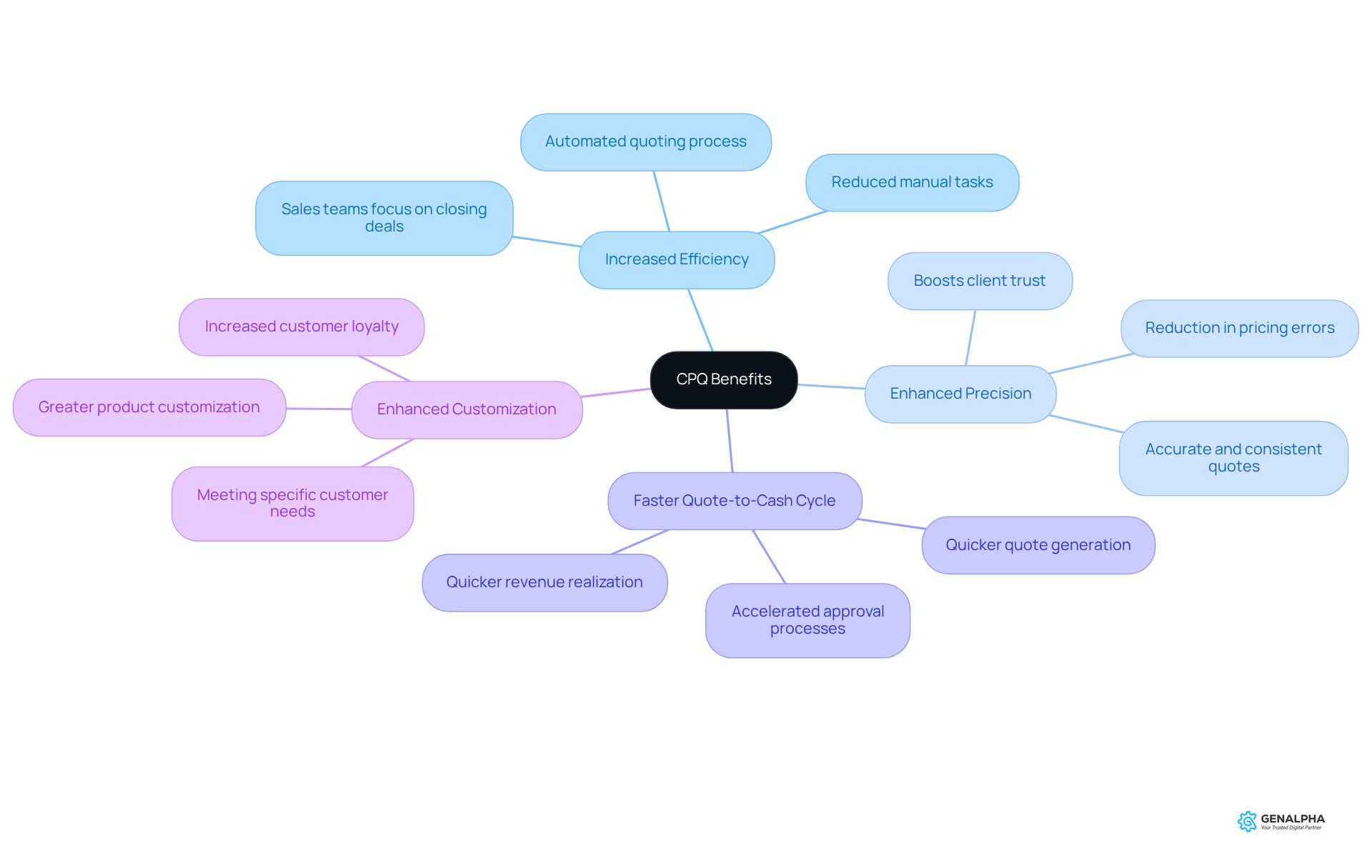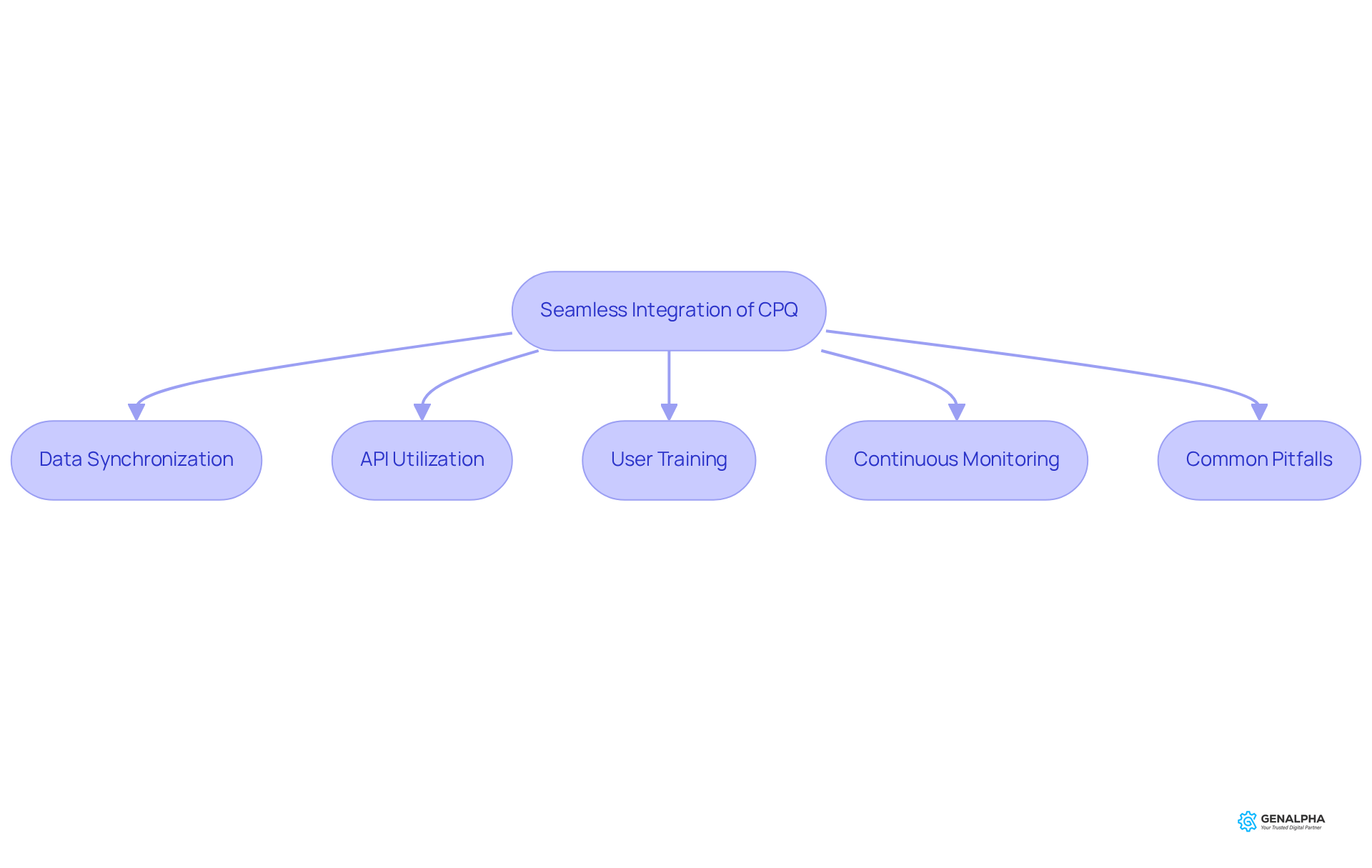Overview
Have you ever wondered how some manufacturers seem to breeze through their sales processes? Well, CPQ solutions are the secret sauce behind that efficiency! By automating the configuration, pricing, and quoting processes, these tools not only speed up sales cycles but also boost accuracy. Imagine a world where companies that implement CPQ see a whopping 300% increase in quoting speed and a 45% drop in pricing errors. That’s not just impressive; it’s a game changer for sales operations and customer satisfaction!
So, what does this mean for you? If you’re in the manufacturing sector, embracing CPQ could transform how you do business. It’s not just about numbers; it’s about creating a smoother experience for both your team and your customers. Why not explore how these solutions can enhance your operations? After all, isn’t it time to elevate your sales game?
Introduction
Today’s manufacturers are navigating a selling landscape that’s more complex than ever. Efficiency and accuracy aren’t just nice to have—they’re essential. Enter CPQ (Configure, Price, Quote) solutions, which are shaking things up by automating the sales process. They help streamline product configuration, pricing, and quoting, making life a bit easier. But here’s the catch: implementing these solutions effectively is where the real challenge lies. So, how can manufacturers embark on this intricate journey to boost operational efficiency and keep customers happy?
Understand CPQ Solutions: Definition and Core Functions
Have you ever thought about how complex selling can get for manufacturers? Enter CPQ solutions—a game-changer that automates and simplifies the whole selling process. With CPQ solutions, sales teams can , price them just right according to what clients want, and whip up quotes in no time. This means not only smoother operations but also happier customers!
Let’s break down what CPQ can do:
- Configuration: Imagine being able to customize products exactly how your customer wants them. That’s what this feature does, ensuring every specification is spot on.
- Pricing: No more guesswork! CPQ software automatically figures out prices based on set rules, discounts, and profit margins. This dramatically cuts down on errors—some studies show accuracy can improve by up to 99%!
- Citing: Need to send out professional estimates quickly? CPQ has got you covered. It speeds up the quoting process significantly. In fact, companies using CPQ have reported a staggering 300% boost in quoting speed, turning hours of work into mere minutes.
The benefits of adopting CPQ solutions are clear. Take the Manitou Group, for example—they slashed their order configuration time from 30 days to just a few hours, with over 95% of orders now coming through an online dealer portal. Talk about efficiency! This not only streamlined their operations but also boosted revenue per order.
And here’s where things get exciting: the latest trends in CPQ software are all about integrating AI and machine learning. This means sales teams can offer tailored deals and adjust pricing on the fly. As the CPQ market evolves, producers who embrace CPQ solutions are likely to see faster transaction cycles, higher success rates, and stronger customer loyalty. Sounds promising, right?
Before diving in, though, it’s crucial for producers to assess their needs thoroughly and choose a skilled CPQ partner. This step is key to ensuring everything rolls out smoothly. So, are you ready to explore how CPQ can transform your sales process?

Leverage CPQ Benefits: Enhancing Efficiency and Accuracy in Manufacturing
Implementing cpq solutions can truly transform the game for manufacturers. Let’s dive into some of the perks:
- Increased Efficiency: Imagine automating the quoting process! This means manufacturers can cut down on the time spent on manual tasks, letting sales teams focus on what they do best—closing deals.
- Enhanced Precision: With CPQ, you can kiss those human errors goodbye. It ensures that quotes are accurate and consistent, which in turn boosts client trust. Who doesn’t want that?
- Faster Quote-to-Cash Cycle: Think about how much quicker your sales cycles could be with faster quote generation and approval processes. This can lead to quicker revenue realization, and who wouldn’t want that?
- Enhanced Customization: CPQ opens the door to greater product customization. This means manufacturers can , leading to happier customers and increased loyalty.
Real-world examples show that companies leveraging CPQ have reported up to a 30% reduction in quoting time and a significant decrease in pricing errors. Isn’t that impressive? So, why not consider how CPQ could benefit your business? Let’s explore the possibilities together!

Implement CPQ Solutions: Step-by-Step Guide for Manufacturers
To successfully implement CPQ solutions, manufacturers should follow these steps:
- Assess Current Processes: Start by taking a good look at your existing quoting and transaction procedures. What’s working? What’s not? Pinpointing inefficiencies can lead to some big improvements. This foundational step is key—companies that assess their workflows can expect a after implementation, especially when they utilize CPQ solutions.
- Define Requirements: Next up, let’s get clear on what you need from the CPQ solution. What features are must-haves? How about integrations and scalability? Setting measurable goals now will make your implementation way more effective.
- Choose the Right CPQ Vendor: Now, it’s time to research and pick a CPQ vendor that fits your business needs. Look for suppliers that offer customizable solutions and have a solid track record in manufacturing. This can lead to a 10% boost in deal size and better client retention.
- Customize the Solution: Work closely with your vendor to tailor the CPQ system to your unique product offerings and pricing structures. Customization is crucial—it ensures the CPQ tool tackles the specific challenges your organization faces. Plus, think about how AI-driven CPQ can automate pricing adjustments based on customer purchase history and market demand, making everything more efficient.
- Train Your Team: Don’t forget about training! Implement comprehensive programs for your support teams so they feel confident using the new system. Well-trained users are not only more assured but also more efficient, leading to better revenue outcomes and a smoother transition. Watch out for common pitfalls like insufficient training that can slow down the process.
- Monitor and Optimize: After you’ve implemented the system, keep an eye on its performance and gather user feedback for adjustments. Regularly reviewing key performance indicators can help you spot bottlenecks and optimize the quoting process, ultimately boosting operational efficiency. And make sure the CPQ solution integrates seamlessly with your existing tech stack to get the most out of it.
By following these organized steps, producers can smoothly transition to utilizing CPQ solutions, unlocking significant benefits such as improved sales efficiency and increased client satisfaction.

Ensure Seamless Integration: Connecting CPQ with Existing Systems
Integrating cpq solutions with your existing systems, such as ERP and CRM, can significantly enhance their effectiveness. So, what should you keep in mind for a seamless integration?
First off, let’s talk about Data Synchronization. It’s all about ensuring a smooth data flow between cpq solutions and other systems. Why is this important? Well, maintaining accurate pricing, inventory, and customer information is crucial. In fact, manufacturers have reported a 45% reduction in pricing errors after implementing integrated systems. That’s a big deal!
Next, consider API Utilization. Make the most of the APIs that cpq solutions vendors provide. They can help you integrate with your existing software and create custom solutions tailored to your specific business needs. This can really enhance operational efficiency by using cpq solutions to automate data movement and reduce manual entry errors.
Now, let’s not forget about User Training. It’s essential to train your staff on how to navigate these integrated systems. When your team knows how to use the resources available, it leads to smoother operations and boosts productivity.
Additionally, think about Continuous Monitoring. Regularly assess your integration to spot any issues or areas for improvement. This ongoing observation helps keep data precise and operations effective, which is key to enhancing client experiences.
And, of course, be aware of Common Pitfalls. Avoid the trap of not clearly defining data rules upfront or trying to build the integration without expert guidance. Tackling these challenges can save you from costly errors and ensure a smoother integration process.
When done right, successful integration of cpq solutions can lead to , fewer errors, and better customer experiences. Take cpq solutions from Bevolo Lighting, for example. They integrated their ERP with CPQ solutions from Salesforce and saw significant time savings and improved quote accuracy. Plus, 75% of manufacturers using Salesforce CPQ report smoother collaboration across departments. That’s the kind of tangible benefit you want!
So, what are you waiting for? Let’s make integration work for you!

Conclusion
Embracing CPQ solutions is a game-changer for manufacturers looking to boost their sales processes and operational efficiency. By automating those tricky configurations, pricing, and quoting, CPQ tools not only make workflows smoother but also ramp up customer satisfaction. Plus, when you integrate these solutions into your existing systems, you really amplify their effectiveness, helping you stay competitive in a constantly changing market.
Throughout this article, we've highlighted some key practices for successfully implementing CPQ solutions. Have you thought about:
- Understanding the core functions of CPQ?
- Assessing your current processes?
- Defining your requirements and selecting the right vendor?
These are crucial steps for a seamless transition. The benefits—like increased efficiency, enhanced accuracy, and quicker quote-to-cash cycles—really showcase the value CPQ solutions can bring to manufacturing businesses.
Ultimately, integrating CPQ solutions isn’t just about jumping on the latest tech trend; it’s about rethinking how you can optimize your sales processes for better performance and customer engagement. So, what’s next? Manufacturers should take proactive steps to assess their needs, invest in the right tools, and train their teams effectively. By doing this, you can unlock significant advantages that drive growth and foster long-term customer loyalty in today’s competitive landscape. Are you ready to take that leap?
Frequently Asked Questions
What is a CPQ solution?
CPQ solutions, or Configure, Price, Quote solutions, are tools that automate and simplify the selling process for manufacturers. They help sales teams configure products, price them accurately, and generate quotes efficiently.
What are the core functions of CPQ solutions?
The core functions of CPQ solutions include configuration (customizing products to customer specifications), pricing (automatically determining prices based on rules and discounts), and citing (speeding up the quoting process).
How does CPQ software improve pricing accuracy?
CPQ software eliminates guesswork by automatically calculating prices according to set rules, discounts, and profit margins, which can improve pricing accuracy by up to 99%.
How much does CPQ software increase quoting speed?
Companies using CPQ solutions have reported a 300% increase in quoting speed, allowing them to turn hours of work into mere minutes.
Can you provide an example of a company that benefited from CPQ solutions?
The Manitou Group reduced their order configuration time from 30 days to just a few hours, with over 95% of orders processed through an online dealer portal, significantly improving efficiency and boosting revenue per order.
What are the latest trends in CPQ software?
The latest trends in CPQ software involve integrating AI and machine learning, enabling sales teams to offer tailored deals and adjust pricing in real-time.
What should producers consider before implementing CPQ solutions?
Producers should thoroughly assess their needs and choose a skilled CPQ partner to ensure a smooth rollout of the solutions.




